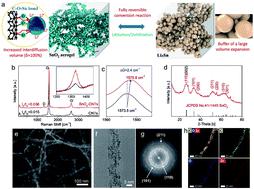当前位置:
X-MOL 学术
›
J. Mater. Chem. A
›
论文详情
Our official English website, www.x-mol.net, welcomes your
feedback! (Note: you will need to create a separate account there.)
Unconventional capacity increase kinetics of a chemically engineered SnO2 aerogel anode for long-term stable lithium-ion batteries
Journal of Materials Chemistry A ( IF 10.7 ) Pub Date : 2020-04-03 , DOI: 10.1039/d0ta02188a Sung Mi Jung 1, 2, 3, 4 , Dong Won Kim 3, 4, 5, 6 , Hyun Young Jung 3, 4, 5, 6
Journal of Materials Chemistry A ( IF 10.7 ) Pub Date : 2020-04-03 , DOI: 10.1039/d0ta02188a Sung Mi Jung 1, 2, 3, 4 , Dong Won Kim 3, 4, 5, 6 , Hyun Young Jung 3, 4, 5, 6
Affiliation

|
Conversion-type materials are attractive candidates as anodes for next-generation batteries due to their high theoretical capacity. However, their irreversible conversion and excessive volume expansion during charge and discharge cycles present many limitations in practical applications. Here, we report a chemically engineered 3D SnO2 aerogel anode with significantly improved reversible capacity and excellent cyclic retention for Li-ion storage. Uniformly distributed SnO2 nanoparticles with sub-3 nm size are chemically bonded on 3D porous carbon nanotube networks through a facile dip coating method without heat treatment. The ultrafine SnO2 nanoparticles contribute significantly to capacity improvement by increasing the interdiffusion layer by the size effect. Also, the electrochemical synergistic effect between the SnO2 and carbon matrix and the open porous structures of the aerogel electrode facilitates significantly enhanced reversibility in the conversion between Li2O/Sn and SnO2 through rapid electron transfer and multidimensional Li-ion accessibility, respectively. Furthermore, the robust structure of the binder-free, freestanding aerogel electrode effectively buffers the massive volume expansion during the charge/discharge process through novel spatial confinement. As a result, the chemically engineered SnO2 anode delivers the highest reversible capacity of about 2031 mA h g−1 with a 200% capacity increase after the 600th cycle at 1C. Such an increased capacity is mainly driven by a rise of the conversion reaction activity where the capacity ratio of the conversion reaction to the dealloying reaction increases up to 2.6 fold. It also presents gradually increasing capacity up to 224 mA h g−1 at 10C and superior cyclability over 10 000 cycles under high C-rates without an evident capacity fading tendency. This study provides new insights into the practical design of highly reversible conversion-type electrodes and ultralight energy storage devices.
中文翻译:

用于长期稳定的锂离子电池的化学工程SnO2气凝胶阳极的非常规容量增加动力学
转换型材料因其理论容量高而成为下一代电池阳极的诱人候选物。然而,它们在充电和放电循环期间不可逆的转换和过度的体积膨胀在实际应用中提出了许多限制。在这里,我们报告了一种经过化学工程处理的3D SnO 2气凝胶阳极,具有显着提高的可逆容量和出色的锂离子存储循环保持力。通过简便的浸涂方法,无需热处理即可将尺寸小于3 nm的均匀分布的SnO 2纳米颗粒化学键合到3D多孔碳纳米管网络上。超细SnO 2纳米颗粒通过尺寸效应增加相互扩散层,从而显着地促进了容量的提高。此外,SnO 2和碳基体之间的电化学协同效应以及气凝胶电极的开放多孔结构分别通过快速电子转移和多维Li离子可及性,显着增强了Li 2 O / Sn和SnO 2之间的转化可逆性。。此外,无粘结剂,独立式气凝胶电极的坚固结构通过新颖的空间限制有效地缓冲了充电/放电过程中的大量体积膨胀。结果,经过化学工程处理的SnO 2阳极可提供约2031 mA hg -1的最高可逆容量,在1C下进行600次循环后,容量可增加200%。这种增加的容量主要由转化反应活性的提高驱动,其中转化反应与脱合金反应的容量比提高至2.6倍。它还显示出在10C时容量逐渐增加至224 mA hg -1的情况,并且在高C速率下在10000次循环中具有出色的循环能力,而没有明显的容量衰减趋势。这项研究为高度可逆转换型电极和超轻型储能器件的实际设计提供了新的见识。
更新日期:2020-04-03
中文翻译:

用于长期稳定的锂离子电池的化学工程SnO2气凝胶阳极的非常规容量增加动力学
转换型材料因其理论容量高而成为下一代电池阳极的诱人候选物。然而,它们在充电和放电循环期间不可逆的转换和过度的体积膨胀在实际应用中提出了许多限制。在这里,我们报告了一种经过化学工程处理的3D SnO 2气凝胶阳极,具有显着提高的可逆容量和出色的锂离子存储循环保持力。通过简便的浸涂方法,无需热处理即可将尺寸小于3 nm的均匀分布的SnO 2纳米颗粒化学键合到3D多孔碳纳米管网络上。超细SnO 2纳米颗粒通过尺寸效应增加相互扩散层,从而显着地促进了容量的提高。此外,SnO 2和碳基体之间的电化学协同效应以及气凝胶电极的开放多孔结构分别通过快速电子转移和多维Li离子可及性,显着增强了Li 2 O / Sn和SnO 2之间的转化可逆性。。此外,无粘结剂,独立式气凝胶电极的坚固结构通过新颖的空间限制有效地缓冲了充电/放电过程中的大量体积膨胀。结果,经过化学工程处理的SnO 2阳极可提供约2031 mA hg -1的最高可逆容量,在1C下进行600次循环后,容量可增加200%。这种增加的容量主要由转化反应活性的提高驱动,其中转化反应与脱合金反应的容量比提高至2.6倍。它还显示出在10C时容量逐渐增加至224 mA hg -1的情况,并且在高C速率下在10000次循环中具有出色的循环能力,而没有明显的容量衰减趋势。这项研究为高度可逆转换型电极和超轻型储能器件的实际设计提供了新的见识。











































 京公网安备 11010802027423号
京公网安备 11010802027423号